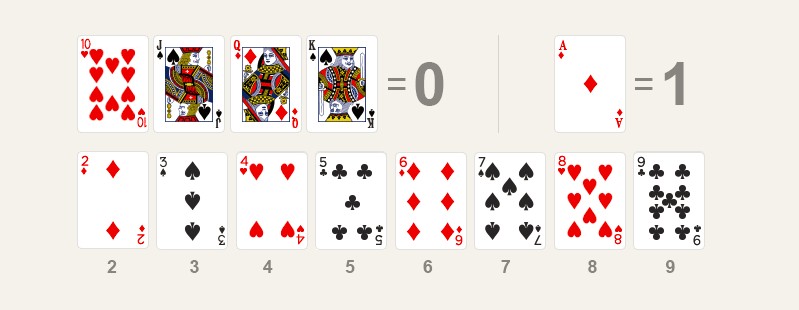Baccarat Rules and How to Play
Baccarat, sometimes called Punto Banco, is a simple casino card game with only three possible bets. In Baccarat, play only against the house - represented by a casino employee called ‘the banker’. |
||||||||||||||||||
|---|---|---|---|---|---|---|---|---|---|---|---|---|---|---|---|---|---|---|
|
|
|
Player Drew |
Banker Draws With |
Banker Stand With |
|---|---|---|
| 2 or 3 |
0-4 |
5-7 |
| 4 or 5 |
0-5 |
6-7 |
| 6 or 7 |
0-6 |
7 |
| 8 |
0-2 |
3-7 |
| 9, 10 or face card |
0-3 |
4-7 |
After the drawing phase is completed the scores of the two hands are compared. The hand with score closest to 9 wins; if the scores are the same then bets on a Tie win with other bets are a push (players get their initial bet back).
House edge and payouts in Baccarat
Baccarat has become popular for its easy gameplay and low house edge. Whilst it used to be popular in Europe (especially Monaco and Monte Carlo) it has found a new lease of life in online casinos and in Asia where it is popular with high rollers.
Bets on Player pay out at evens (1:1) and have a house edge of just 1.24%, while bets on the Banker have a slightly lower house edge, at 1.06% but pay out at 19:20. This slightly lower payout is explained by a 5% commission on winning Banker bets.
Bets on a Tie are a slightly different proposition. Depending on where you play Tie bets pay out at either 8:1, creating a massive house edge of 14.4% or 9:1 which reduces the house edge to 4.8%.
History of Baccarat
Like all good casino games Baccarat has a long and disreputable history. It is first documented as being played in 15th century France and was a favourite of the French court at a time when gambling was heavily frowned upon.
The game was subsequently the centre of a high society scandal in Victorian England. In an incident known as the Tranby Croft Affair the Prince of Wales and future King of England was playing baccarat, which was illegal at the time. Unfortunately one of the guests, Sir William Gordon-Cumming, was accused of cheating, which he strongly denied.
The affair was meant to be settled privately, with Sir William promising in writing to not gamble again. Unfortunately the Prince’s mistress began to spread gossip, Sir William becoming an outcast in high society. Eventually he sued his accusers for slander, creating a scandal which damaged the Prince and compelled him to testify in court. Sir William lost his case and was dismissed from the army, retiring in shame to Scotland.
James Bond and Chemin de Fer
The recent James Bond Film Casino Royale shows 007 facing Le Chiffre over an intense game of Poker. Did you know that in the original novel the game of choice was Baccarat?
In an older version of Baccarat, called Chemin de Fer, players would bid to ‘go bank’, buying the right to play as the Banker for that hand. In the 1953 novel (the first Bond book), Bond faces his adversary over a high stakes game, daring his opponent into a rash bet which bankrupts him.


